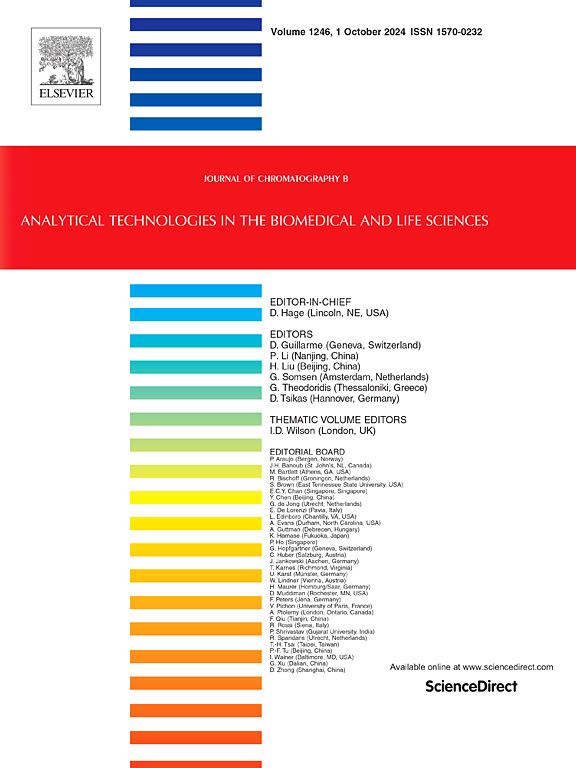DNA-protective and antioxidant potentials of thym samples: Chemometric and bioactive profiling from Iraq's Kurdish highlands and Siirt, Türkiye
IF 2.8
3区 医学
Q2 BIOCHEMICAL RESEARCH METHODS
引用次数: 0
Abstract
Thyme, a fragrant herb from the Lamiaceae family, is highly valued for its essential oil content, making it a key ingredient in perfumery, aromatherapy, phytotherapy, and pharmacology. This study investigates the chemical composition and biological activity of thyme samples collected from Iraq's Kurdish Region (Qandil, Asos, Balambo, Karokh) and Siirt, Türkiye (Eruh, Şirvan, Kezer, Tillo, and other regions). Comprehensive analyses were conducted to assess micro- and macro-element levels, total phenolic and flavonoid content, and antioxidant properties using methanolic extracts. The highest phenolic and flavonoid contents were 226.83 ± 0.21 mg/mL gallic acid equivalent (GAE) and 2.59 ± 0.02 mg/mL of routine equivalents (RE). Antioxidant activity, evaluated via FRAP and DPPH assays, demonstrated IC50 values of 1.32 mg/mL and 2.05 mg/mL. Maximum metal chelation was 22.92 %. LC-MS/MS identified 29 out of 37 phenolic compounds, including abundant levels of hesperidin (62.37 ± 0.02 μg/kg), rosmarinic acid (19.90 ± 0.01 μg/kg), and Ferulic acid (2.23 ± 0.01 μg/kg). Chemometric analyses, including PCA and cluster analysis, highlighted regional differences. Hydroxyl radicals (•OH) produced through the Fenton reaction involving H₂O₂ and Fe(II) cause damage to the pBR322 plasmid DNA. This damage is evidenced by a reduction in the supercoiled form and an increase in relaxed or linear DNA forms following oxidative stress. DNA damage assays demonstrated that thyme extracts provided partial protection against Fenton reaction-induced damage without compromising DNA integrity. These findings emphasize thyme's potential for pharmaceutical, nutritional, and industrial applications.

胸腺样品的dna保护和抗氧化潜力:来自伊拉克库尔德高地和锡尔特的化学计量学和生物活性分析
百里香,一种来自Lamiaceae家族的芳香草本植物,因其精油含量而受到高度重视,使其成为香水,芳香疗法,植物疗法和药理学的关键成分。本研究调查了从伊拉克库尔德地区(Qandil, Asos, Balambo, Karokh)和Siirt, t rkiye (Eruh, Şirvan, Kezer, Tillo等地区)采集的百里香样品的化学成分和生物活性。综合分析了甲醇提取物的微量元素和常量元素含量、总酚和类黄酮含量以及抗氧化性能。高酚类和黄酮含量分别为226.83±0.21 mg/mL没食子酸当量(GAE)和2.59±0.02 mg/mL常规当量(RE)。通过FRAP和DPPH测定抗氧化活性,IC50值分别为1.32 mg/mL和2.05 mg/mL。最大金属螯合率为22.92%。LC-MS/MS鉴定出37种酚类化合物中的29种,其中橙皮苷(62.37±0.02 μg/kg)、迷迭香酸(19.90±0.01 μg/kg)和阿魏酸(2.23±0.01 μg/kg)含量丰富。化学计量分析,包括主成分分析和聚类分析,突出了区域差异。羟基自由基(•OH)通过涉及H₂O₂和Fe(II)的芬顿反应产生,导致pBR322质粒DNA损伤。氧化应激后超卷曲形式的减少和松弛或线状DNA形式的增加证明了这种损伤。DNA损伤分析表明,百里香提取物在不损害DNA完整性的情况下,对芬顿反应引起的损伤提供了部分保护。这些发现强调了百里香在制药、营养和工业应用方面的潜力。
本文章由计算机程序翻译,如有差异,请以英文原文为准。
求助全文
约1分钟内获得全文
求助全文
来源期刊

Journal of Chromatography B
医学-分析化学
CiteScore
5.60
自引率
3.30%
发文量
306
审稿时长
44 days
期刊介绍:
The Journal of Chromatography B publishes papers on developments in separation science relevant to biology and biomedical research including both fundamental advances and applications. Analytical techniques which may be considered include the various facets of chromatography, electrophoresis and related methods, affinity and immunoaffinity-based methodologies, hyphenated and other multi-dimensional techniques, and microanalytical approaches. The journal also considers articles reporting developments in sample preparation, detection techniques including mass spectrometry, and data handling and analysis.
Developments related to preparative separations for the isolation and purification of components of biological systems may be published, including chromatographic and electrophoretic methods, affinity separations, field flow fractionation and other preparative approaches.
Applications to the analysis of biological systems and samples will be considered when the analytical science contains a significant element of novelty, e.g. a new approach to the separation of a compound, novel combination of analytical techniques, or significantly improved analytical performance.
 求助内容:
求助内容: 应助结果提醒方式:
应助结果提醒方式:


